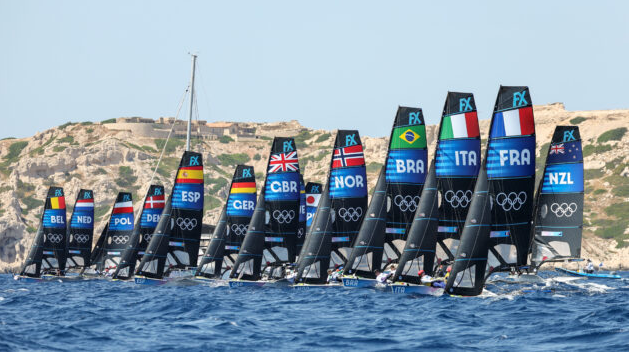What I love about the Olympics is how it gets me excited about sports I wouldn’t usually follow. The Olympics are like a diverse buffet, offering a taste of many different events. If something doesn’t capture your interest, you can always try something else. After diving into Olympic sailing, I had a lot of questions about how it works.
Here’s a guide to some of the basics of Olympic sailing:
**How does the start work in Olympic Sailing?**
Races start with a 5-minute countdown. During this time, competitors position themselves to gain an advantage. The start line is set perpendicular to the wind, with one end known as the ‘pin end’ and the other as the ‘committee boat end’ or ‘boat end’. The ‘boat end’ features a vessel with flags used for the countdown, while the ‘pin end’ is marked by a buoy.
Sailboats can’t sail directly into the wind, so they zig-zag towards the first mark, which is upwind. Sailors choose their position on the start line based on the wind and the potential bias of the line, which might make one end more advantageous.
**Why might Olympic Sailing be delayed?**
Sailing depends heavily on wind conditions, so races can be delayed due to the wind. Low wind speeds can cause postponements, and extreme winds can also delay starts. Additionally, inconsistent wind direction can prevent race officials from setting a course. Fortunately, sailing can accommodate a range of conditions, so races often proceed once conditions stabilize.
**How much wind is needed for a sailing race?**
Wind speed is measured in knots, where one knot equals about 1.15 miles per hour or 1.85 kilometers per hour. Generally, winds below 5 knots are too light, and winds above 30 knots are too strong for racing.
**What does it mean when the wind is "filling in"?**
Wind conditions can vary across the course, with stronger winds in some areas. When commentators say the wind is "filling in," they mean that the wind is increasing or becoming more consistent in a specific area, helping boats sail faster. Sailors look for these strong wind patches to gain an advantage.
**Why do boats keep changing direction?**
Boats can’t sail straight into the wind, so they zig-zag (or tack) to make progress upwind. This involves sailing "close hauled" on one tack, then changing direction to sail on the other tack. Boats sail around course marks and often zig-zag when sailing downwind to maintain speed.
**What is the sail that sometimes disappears?**
That’s the spinnaker—a large, colorful sail used to boost speed when sailing downwind. Sailors pull it out when heading downwind and tuck it away when sailing upwind, making it appear as though it vanishes.
A layline is an imaginary line that shows the optimal point for changing direction to reach a mark. When sailing upwind, the layline is at a 45º angle from the wind, guiding sailors on when to tack or gybe to reach the mark efficiently.
In Olympic sailing, sailors use their body weight to counterbalance the wind's force. Trapezing involves standing on the side of the boat, supported by ropes attached to the mast. This technique helps sailors balance the boat and sail faster. Hiking, another technique, involves leaning out over the side of the boat while hooked into straps, which also helps balance the boat.
I hope this helps you better understand and enjoy Olympic sailing!

